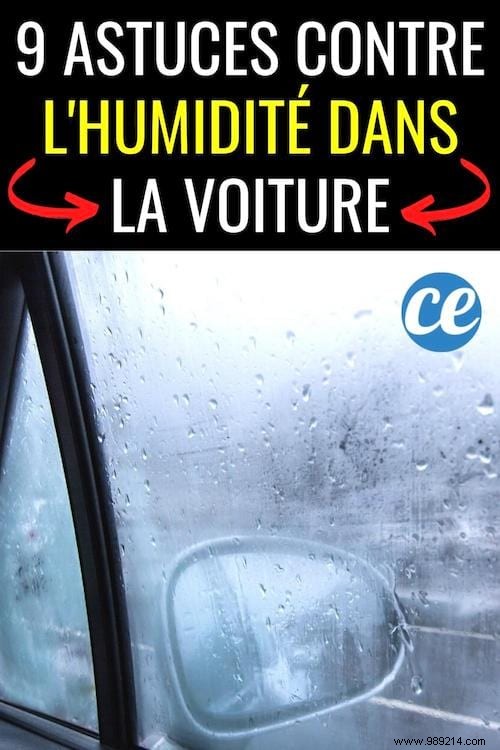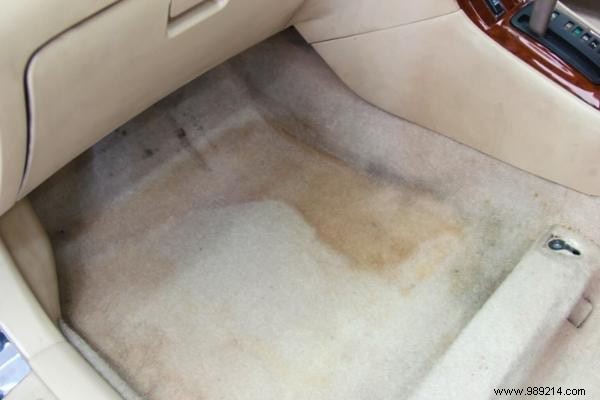
Today I show you how to prevent humidity from getting installs in your car.
Because having condensation inside the passenger compartment is downright annoying and even dangerous.
Not to mention the rather unpleasant musty smells...
And I'm sure that like me, you think that it's because of the bad weather that the humidity arrives...
Well no; when humidity sets in, it is usually due to a lack of maintenance on our part!
You have to understand where the problem is coming from and act quickly.
Discover the 9 mistakes to avoid to prevent humidity from settling in your car. Watch:


The humidity accumulated in the passenger compartment of the car is a real poison.
Beyond the fact that this causes the windows to fog up, it also increases the risk of an accident.
Blind spots are multiplying and it can be very dangerous.
And I'm not even talking about the health problems that this can cause in the long term.
Bacteria, respiratory allergy, cough, shortness of breath or even asthma...
These are the festivities that await us if we do nothing.
And then, once the humidity has set in, it is especially difficult to part with it.
It can even cause problems with the engine, headlights, spark plugs, etc.
And that can be a problem if you ever want to sell the car.
So to avoid this phenomenon, be careful not to make the following mistakes.

You know, it is the canals that have the mission of evacuating rainwater.
They are found between the windshield and the hood, around your sunroof or in the back of the car.
They are often clogged with junk and because of this no longer evacuate water when it rains!
So go around your car regularly and remove this dirt by hand.
And then, when you service the car, have your roof checked for leaks.
And yes, you certainly hadn't thought of it, but if the water drains badly, it's humidity that sets in.

This is the so-called Pollen filter.
We do not think of replacing it and yet it must be changed at least once a year.
Take advantage of draining it to replace it.
Because believe me, when it gets dirty, it generates a lot of humidity.
Why?
Because the dirt on the filter prevents the air from circulating normally.
And who says less air coming in, says more humidity.
In addition, bacteria settle which is not good for health.
So don't forget to change it.
Especially since it is not expensive (between 10 and 20 euros) and is easy to change.

Taking to the road without ventilating the cabin, is keeping and accumulating humidity inside.
I therefore advise you, to avoid this, to operate the ventilation.
And to make it doubly effective, run it with hot air.
This allows moisture to evaporate better.
If you have any doubts about whether this consumes your gas, check out this trick.
She explains that this is not the case at all.
Finally, when the heater is not yet hot, the air you breathe causes humidity and fogging.
In this case, quickly open your windows to let the stagnant humidity escape inside.
Yes, the air conditioning is not only made to cool the passenger compartment.
It also dries the air quickly and fights humidity.
It is even more efficient than heating.
But that's not all.
The air conditioning lubricates the seals, prevents the formation of fungi, removes bad odors and avoids rapid degradation!
So even when it's cold, use the air conditioning.
To maintain and have maximum efficiency, don't forget to carry out regular maintenance on your air conditioning.

To keep your passenger compartment as dry as possible, avoid all sources of humidity.
So when it's raining or snowing, don't get into your car with your wet clothes on.
Put them in your trunk and pat your shoes on before getting in.
Another tip; your floor mats should not stay wet either. They also need to be dried.
For the lucky ones, if your car is sleeping in the garage, leave the windows open at least one centimeter to ventilate.

Floor mats are not the only interior textiles that can become damp.
Also examine the carpet between the chassis and the mats, especially if you smell musty odors.
There must be no humidity, which can happen by capillary rise.
Believe me, damp fabrics in a car often have a hard time drying.
This should not be taken lightly.
If your carpet is indeed soaked, there are natural tricks to dehumidify all that.
For example, you can place newspaper on the floor. This allows moisture to be absorbed.
You can even make your own drying elements.
In an old pair of socks, put charcoal, silica kitty litter, salt or rice.
Place your magic preparation on the damp places and let it act. Smart No?

Varying temperatures and bad weather put the seals to the test.
You don't necessarily pay attention to it, but the rubber quickly becomes more waterproof over time.
And porous gaskets let moisture into the car.
The maintenance of the seals is therefore not optional if you want to protect your coach properly!
Suitable products exist to maintain the flexibility and efficiency of rubbers.

You know it like me, water seeps everywhere and especially through the smallest hole.
And on a car, corrosion of the body leads to the formation of small holes.
Do you see where I'm coming from?
Rust eats the bodywork and water seeps into it. This creates moisture pockets.
Besides, what's annoying is that it doesn't only happen on the visible parts.
Often the entry points are under the car.
A small regular examination of the underbody is therefore not a luxury.

As with the air conditioning, the heating of a car must be serviced regularly.
Abnormal humidity in the passenger compartment may be caused by a leak in the heating circuit.
Result:never-ending humidity and a weird smell.
To check this, switch on the heating and the ventilation of the screen.
If it fogs up, the heat exchanger is damaged.
If your floor is wet, sponge with a paper towel and look at the color.
If the water is colored, your exchanger must also be replaced.
So it's not expensive (between 15 and 30 euros), but it's quite complex to change.
Find out from the green light type professionals, Norauto, to find out how to do it.

As with your home, a car needs airing for a few minutes a day.
If this is not feasible, the use of a Rubson type dehumidifier is quite possible and effective.
It's a real humidity sensor.
Since they are less powerful than those used for home use, they must be left to act overnight.
Car dehumidifiers come in 3 categories:
Those with condensation:they collect the humidity of the air in a container.
Those with humidity absorber:they draw air through a fan on a honeycomb wheel.
Those with absorption equipped with hygroscopic salt of calcium chloride, with a tank to collect the water.
There you go, you now know what mistakes to avoid so as not to see moisture settling on the windows :-)
Various "anti-humidity" actions are therefore to be implemented to eliminate excessive humidity.
They prevent mold that can build up on your seats and inside the cabin.
No more need to remove and clean stains or traces of humidity since you have definitely chased them away!
And obviously, it works for any type of vehicle. From the Golf Diesel to the Clio to the electric Tesla.
Have you tried these tips to avoid humidity in the car? Let us know in the comments if it worked. We can't wait to read you!